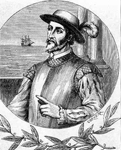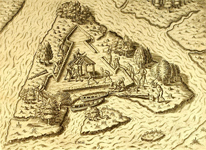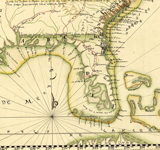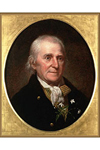16th-18th Centuries |
| Pre-History | 16th-18th Centuries | 19th Century | 20th Century | 21th Century |
| Visit the main River Returns web site >> |
| |
|
|
1513
Ponce de Leon Arrives from Spain
In April of 1513, Spanish explorer Ponce de Leon arrived on the northeast coast of Florida, near present-day St. Augustine. In honor of Spain's Feast of Flowers celebration, he named the area "La Florida."
|
|
|
|
1562
Jean Ribaut Discovers River of May
French naval officer and explorer Jean Ribaut sailed into the St. Johns on May 1, and claimed for France his "discovery" of Riviere de Mai, or River of May. He described in letters home that the area is "the fairest, frutefullest and pleasantest of all the worlds …." He built a stone monument on St. Johns Bluff, claiming the territory for France, and returned to Europe.
|
|
| © Florida Center for Instructional Technology, University of South Florida |
|
1564
Laudonniere Builds Fort Caroline
Jean Ribaut's lieutenant from the 1562 expedition, Rene Goulaine de Laudonniere, returned to "Riviere de Mai" bringing 200 French settlers to a bluff at the mouth of the river. There, almost half a century before the British settled Jamestown, they established Fort Caroline, the first permanent European colony in the New World.
|
|
|
|
1565
Menéndez Captures Fort Caroline
Spanish soldiers, led by Pedro Menéndez de Avilés, captured Fort Caroline, slaughtered the French settlers and renamed the river "Rio de San Mateo" (St. Matthews River) in observance of the saint's feast day that occurred the day after their victory. The fort was renamed San Mateo, and a mission established near the mouth of the river was called San Juan del Puerto (St. John of the Harbor). The river eventually came to be known as the "Rio de San Juan" (St. John's River).
|
|
| © Library of Congress, Geography and Map Division |
|
1568
Spanish Hold Onto Florida
French soldier Dominique de Gourgues, in retaliation for the 1565 massacre of the French settlers, joined forces with Florida's Native Americans, and ruthlessly captured the Spanish fort of San Mateo. The Spanish rebuilt the fort, only to abandon it a year later. Despite the setback, Spain would control much of Florida for the next two centuries.
|
|
|
|
1579
Oranges Begin to Flourish in Florida
By 1579, the Spanish had introduced oranges to Florida. Groves of the fruit flourished, tended to by the Spanish as well as the Timucuan Indians, who carried the fruit as food on hunting trips. In the centuries since, orange cultivation made a significant impact on the landscape of settled areas of Florida and became a mainstay of the economy.
|
|
| © UNESCO's Memory of the World Programme |
|
1763
Two Decades of British Rule
Two decades of British rule began with the signing of the Treaty of Paris between England and Spain, ending the French and Indian War. The British translated and shortened the river's Spanish name from Rio de San Juan to St. John's River. The name remains the same today, except for the dropped apostrophe.
|
|
| © John Bartram Association |
|
1765
John Bartram, America's First Botanist
In December, John Bartram, America's first professional botanist, embarked from St. Augustine for the St. Johns River on a plant collecting trip with his son, William (Billy). Paddling upriver in a dugout battoe the father and son team reached Lake Harney in January 1766.
|
|
|
|
1767
Denys Rolle, Early Florida Developer
Denys Rolle, an English philanthropist and one of Florida's first developers, enticed 49 English colonists - primarily pickpockets, prostitutes and paupers - to the banks of the St. Johns to fulfill his ill-conceived notion of establishing an "Ideal society." The colony of Rollestown was abandoned by its founder in 1783 when a treaty that recognized the United States of America returned Florida to the Spanish.
|
|
|
|
1774
William Bartram, The Flower Hunter
The second Bartram expedition up the St. Johns began on a small sailboat that William (Billy) Bartram purchased in Cowford (present-day Jacksonville). Billy sailed his boat as far south as Blue Springs. Billy, a painter and a poet given to lush images and rhapsodic language, earned a fitting nickname from the Indians: "Puc-Puggy," or Flower-Hunter. His book, Travels, was published in 1791.
|
|
|
|
1784
Florida Returns to Spanish Control
Throughout the War for American Independence, the settlers of Florida remained loyal to Great Britain. Spain, an ally of France during the war, captured Pensacola, in what was then called West Florida, in 1781. In 1784, as part of the peace treaty that ended the Revolutionary War, Spain regained control of the rest of Florida, including the St. Johns River.
|
|









